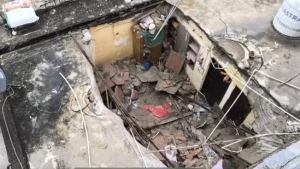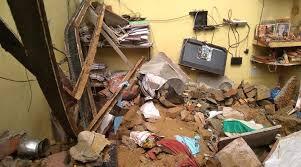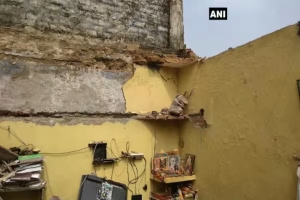New Delhi – A serious structural failure incident occurred in Delhi’s Dwarka district on Tuesday when the Dwarka Roof Collapse injured two people in the Siddhatri Enclave area of Mohan Garden. The incident highlights the ongoing challenges posed by incessant rainfall to Delhi’s aging infrastructure, particularly affecting residential buildings that lack proper structural maintenance and weather resistance.
Incident Details and Location Specifics

The Dwarka Roof Collapse occurred at a four-story building in Siddhatri Enclave, specifically affecting the roof of one room on the fourth floor. Police officials confirmed that the structural failure was directly attributed to incessant rain that had been battering the Delhi region, creating conditions that compromised the building’s structural integrity.
The Dwarka Roof Collapse took place under the jurisdiction of Mohan Garden Police Station area in Dwarka district, highlighting the localized impact of weather-related infrastructure failures. The specific targeting of an upper-floor room suggests that water accumulation and structural weakness combined to create the dangerous conditions leading to the collapse.
Casualty Details and Medical Response
Two individuals sustained injuries in the Dwarka Roof Collapse, with both victims requiring immediate medical attention. Delhi Police confirmed that neither victim suffered life-threatening injuries, indicating that despite the severity of the structural failure, the human impact was relatively contained compared to similar incidents.
The Dwarka Roof Collapse resulted in one victim, identified as Subhash (30), sustaining a fracture to his left forearm, representing the most serious injury documented in the incident. Both injured individuals were promptly transported to Deen Dayal Upadhyay Hospital for comprehensive medical evaluation and treatment.
Hospital Treatment and Recovery


Medical authorities at DDU Hospital provided immediate care to the Dwarka Roof Collapse victims, with both patients receiving treatment and being discharged the same day. The quick discharge indicates that while injuries were sustained, they were not severe enough to require extended hospitalization or intensive medical intervention.
The successful treatment and discharge of Dwarka Roof Collapse victims demonstrates the effectiveness of Delhi’s emergency medical response system in handling structural collapse incidents. The prompt medical care likely prevented complications that could have resulted from delayed treatment of fracture injuries and other trauma.
Structural Analysis and Building Condition


Police statements regarding the Dwarka Roof Collapse specifically noted that the failed structure was described as an “old structure,” suggesting that building age and maintenance issues may have contributed to the structural vulnerability. This characterization raises important questions about building safety standards and regular structural assessments for aging residential buildings.
The Dwarka Roof Collapse affecting specifically one room on the fourth floor indicates localized structural weakness rather than comprehensive building failure. This pattern suggests that targeted maintenance and repair work might have prevented the incident if structural issues had been identified and addressed proactively.
Weather-Related Infrastructure Challenges
The Dwarka Roof Collapse represents part of a broader pattern of weather-related infrastructure failures affecting Delhi during monsoon season. Incessant rainfall creates cumulative stress on building structures, particularly those lacking adequate waterproofing and drainage systems designed to handle sustained water exposure.
Recent incidents demonstrate that the Dwarka Roof Collapse is not an isolated occurrence but part of a concerning trend of structural failures during heavy rainfall periods. These incidents highlight the vulnerability of Delhi’s residential infrastructure to extreme weather events and the need for comprehensive building safety assessments.
Historical Context: Previous Tragic Incidents

The Dwarka Roof Collapse occurs against the backdrop of more serious structural failures in Delhi, including the devastating August 15 incident at Dargah Sharif Patte Shah near Humayun’s Tomb. That previous collapse resulted in six fatalities, demonstrating the potential severity of similar structural failures under different circumstances.
The earlier Humayun’s Tomb area incident prompted extensive investigation and legal action, with Delhi Police registering cases under multiple sections of the Bharatiya Nyaya Sanhita. The Dwarka Roof Collapse, while less severe in terms of casualties, reinforces concerns about systematic building safety issues across Delhi.
Emergency Response and Safety Measures
The Dwarka Roof Collapse triggered immediate emergency response protocols, with police, medical teams, and safety personnel responding promptly to the scene. The coordinated response likely minimized the potential for additional injuries and ensured proper documentation of the incident for future safety analysis.
Following the Dwarka Roof Collapse, authorities implemented standard safety protocols including site cordoning and debris clearance to prevent additional hazards. These measures reflect lessons learned from previous incidents and the importance of comprehensive emergency response procedures.
Prevention and Future Safety Considerations
The Dwarka Roof Collapse underscores the critical need for proactive building safety assessments, particularly for older residential structures vulnerable to weather-related damage. Regular structural inspections and maintenance programs could potentially prevent similar incidents by identifying and addressing structural weaknesses before they result in dangerous failures.
Conclusion
The Dwarka Roof Collapse serves as an important reminder of the ongoing challenges posed by monsoon weather to Delhi’s residential infrastructure. While this incident resulted in relatively minor injuries, it highlights the broader need for comprehensive building safety measures and proactive maintenance to protect residents from weather-related structural failures during Delhi’s challenging monsoon season.

